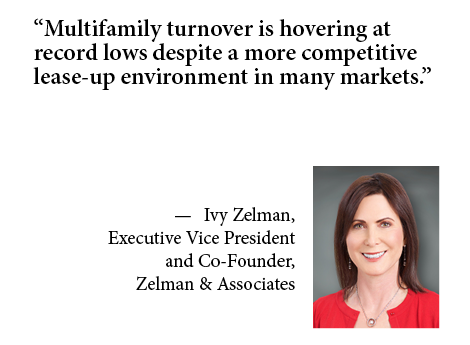Like other property sectors, rental housing assets have experienced big swings in fortunes over the past few years. Historically high rent growth during the pandemic came to a halt amid new supply in many markets. And the end of cheap debt has stymied investment sales and is stressing investors who paid handsomely for apartments using short-term financing.
But the situation could be worse. Housing remains in high demand, and despite higher mortgage rates and a collapse in home sales, a severe lack of inventory on the market continues to prop up home values and price out would-be buyers. In May, home prices across the country increased 5.9 percent over the previous year, according to the latest S&P CoreLogic Case Shiller U.S. National Home Price NSA Index.
Rental housing owners and operators are the obvious beneficiary of those challenges, says Ivy Zelman, executive vice president and co-founder of Zelman & Associates, a Walker & Dunlop company that provides housing research, analysis and consulting. Move-outs attributed to home purchases clearly illustrate the trend.
An apartment and single-family rental operator in Phoenix recently told Zelman that such move-out activity has dropped to about 13 percent from an historical average of 30 percent, she says. Similarly, a multifamily landlord told her that move-outs related to home buying have fallen by half, to around 7 percent.
“The number of homes for sale continues to be highly constrained, and as a result, home price appreciation remains pretty significant,” says Zelman, whose firm is holding its 17th annual housing summit in Boston on September 12 and 13. “Multifamily turnover is hovering at record lows despite a more competitive lease-up environment in many markets.”
Strategy to Survive
Indeed, a supply hangover in some metros, particularly in the Southeast, has prompted multifamily landlords to emphasize tenant retention and occupancy over rent growth in order to sustain cash flow, Zelman adds. The focus on filling properties and keeping them full is happening as the long-range effects of the temporary eviction moratoriums are coming to a close. As a result, the number of people living in buildings while not paying their rent is shrinking.
“There really aren’t eviction moratoriums in place anymore,” Zelman explains. “There’s some noise in California and Atlanta, where it’s a little more difficult to evict tenants in general. But even landlords in those markets are seeing bad debt expense falling below trend lines.”
As one example, she cites Invitation Homes, which owns more than 600 single-family rental homes in Atlanta. During the company’s second quarter earnings call recently, executives reported that bad debt expense had improved for the fifth straight quarter.
Even with the wind-down of eviction moratoriums, the probability of regulation encroachment is a chief concern among investors and lenders, Zelman notes. “Investors continually worry about recessions and similar events,” she states. “But if you prioritize it, regulation is always high on the list of what keeps them up at night.”
Among other policies, some politicians have suggested placing a 5 percent annual cap on rent increases. Details of such a program are unclear at the moment, but even though a cap of that size appears somewhat generous to landlords when compared to historic rent growth, it would still slow new development, she predicts. For that reason, Zelman downplays the chances that such proposals will pass.
Turning the Corner?
Meanwhile, potential changes to energy codes to address climate change fears could add to development costs that are escalating due to a shortage of trade workers, higher material expenses and lingering supply chain issues, she adds. The spike in interest rates has arguably done the most to disrupt multifamily construction as banks vacated the market.
But alternative sources of capital, such as debt funds, are making financing available, albeit at a higher cost than banks, Zelman says. Looking ahead, deep-pocketed developers who are less constrained by elevated interest rates are likely to pursue development as renters absorb excess supply, she continues.
“The momentum seems to be shifting to the rhetoric of, ‘If we don’t start construction of new multifamily units today, by the beginning of 2026, we’re going to be in very short supply,’” Zelman reports. “There’s a little bit more optimism in the market.”
To a certain degree, that goes for investment sales, as well. While completing apartment trades remains challenging overall, more buyers have entered the market, she says.
Moreover, the sense that multifamily cap rates have peaked in geographies not plagued by new supply is gaining momentum, she adds. It’s possible that one or possibly more cuts to the federal funds rate by the Federal Reserve this year could help bring buyers and sellers together.
“If you asked me six month ago, I would have said that the market had hit rock bottom — negative sentiment was everywhere,” Zelman observes. “Today it feels like there’s a little bit more of a skip in the step of investors.”
— By Joe Gose. Walker & Dunlop is a content partner of REBusinessOnline. For more articles from and news about Walker & Dunlop, click here.


